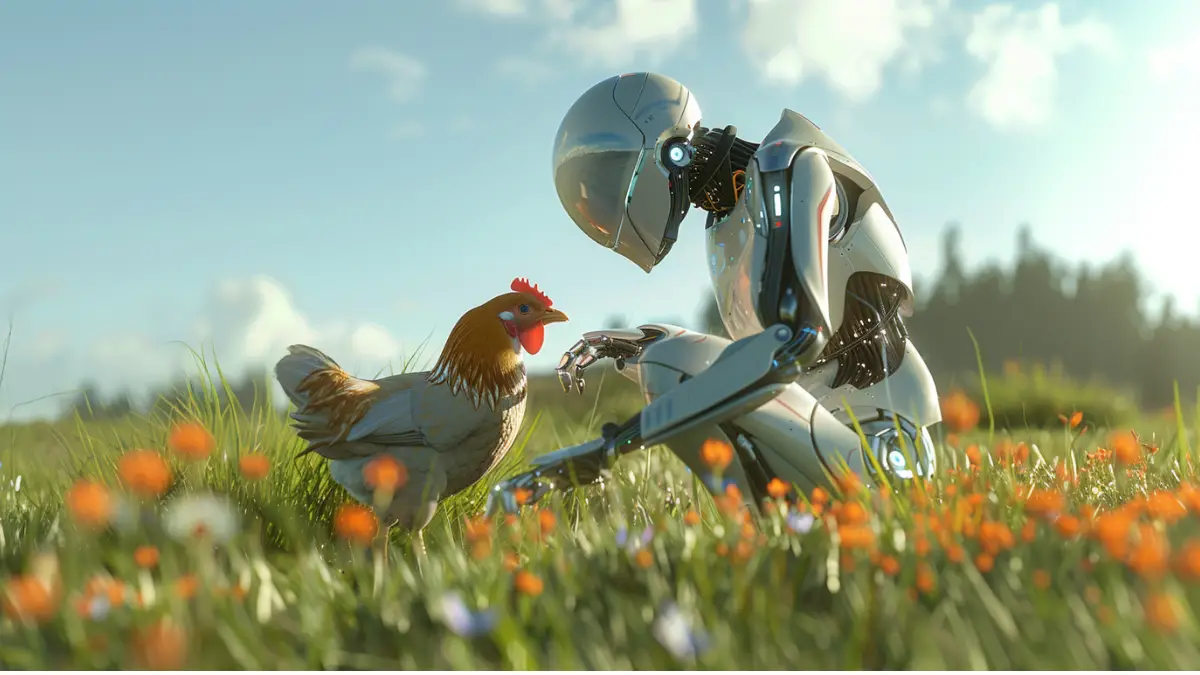In a remarkable breakthrough, researchers in Japan have developed an artificial intelligence system that can interpret the emotions of chickens through their sounds.
From clucks and chirps to squawks, this AI technology, known as Deep Emotional Analysis Learning, is opening a new frontier in understanding animal feelings.
What once sounded like science fiction is now becoming a reality, allowing humans to communicate with animals in ways never thought possible. This development is not only a fascinating scientific achievement but also a potential game changer in animal welfare, ethical farming, and veterinary care.
By analyzing chicken vocalizations, DEAL can identify different emotional states, creating a more empathetic and informed way to interact with animals. Chickens, like many animals, express themselves vocally.
However, until now, humans could only guess what their clucks and squawks meant. The Deep Emotional Analysis Learning system uses advanced machine learning algorithms to decode these vocalizations.
The AI evaluates features like pitch, frequency, duration, and tone, correlating them with observed behaviors such as feeding patterns, movements, or signs of distress. The result is a system capable of detecting emotions such as fear, happiness, excitement, anger, hunger, and contentment.
This breakthrough allows for real time monitoring of chicken emotions, which could transform farming practices and animal care. For instance, by identifying distress early, farmers can prevent disease outbreaks, improve living conditions, and promote overall flock well being.
Real Life Applications of AI in Poultry
A commercial poultry farm in Japan implemented the DEAL system to monitor thousands of chickens. By analyzing vocalizations, the AI detected stress signals caused by overcrowding in certain sections of the barn.
Once adjustments were made to improve ventilation and space, overall chicken health improved, mortality rates dropped, and egg production increased. This demonstrates that understanding animal emotions isn’t just ethical it is also economically beneficial.
Farmers who adopt AI based emotional monitoring can make informed decisions that improve both animal welfare and productivity. Animal welfare organizations are also exploring AI to ensure better living conditions for chickens.
Sanctuaries that house rescued or free range chickens can use AI to monitor emotional well being. If the AI detects prolonged distress, caretakers can intervene by providing enrichment, adjusting feeding routines, or improving shelter conditions.
By applying AI in this way, organizations are taking proactive steps to reduce suffering and ensure that chickens live healthier, happier lives. Experts in animal behavior and AI technology are optimistic about the potential of systems like DEAL.
Professor Adrian David Cheok, a renowned researcher in human animal interaction, says. When we understand what animals are feeling, we can make better decisions for their care and welfare. AI opens doors to empathy on a scale we never imagined.
Veterinarians also see the practical value. Dr. Hideo Takahashi, who collaborated on the project, explains. Early detection of stress and discomfort is key to preventing illness. This AI allows us to monitor animals continuously without causing additional stress.
These expert insights emphasize that the technology is not just a novelty it has real world applications in ethical farming, veterinary care, and animal research.
Farmers and Caretakers Speak
Farmers who have tested AI monitoring report impressive results. One poultry farmer noted. Before using AI, we could only guess when something was wrong. Now, we get real time alerts if chickens show distress. It’s like having a window into their emotions.
Caretakers in animal sanctuaries have shared similar experiences. By responding to distress signals from the AI, they can provide comfort, enrichment, or medical attention, preventing prolonged suffering.
These personal accounts highlight how AI can strengthen the human animal bond and make animal care more precise and compassionate. The DEAL system relies on deep learning and neural networks to process complex vocal patterns.
The AI is trained on thousands of hours of chicken sounds, with each sound correlated to observed behaviors and physiological markers.
The algorithm identifies subtle differences in tone and pitch that indicate emotional states. For example, A high pitched, rapid cluck might indicate fear or anxiety.
A slow, rhythmic cluck often signals contentment or calmness. Repetitive, sharp squawks may suggest hunger or frustration. By analyzing these patterns in combination with behavior.
The AI can predict emotional states with remarkable accuracy. This multi dimensional approach makes DEAL a reliable tool for both research and practical applications.
The Future of AI in Understanding Animals
While DEAL currently focuses on chickens, the potential applications are vast. Researchers are exploring the use of AI to decode emotions in cows, pigs, dogs, cats, and even marine life such as whales and dolphins.
Imagine a future where veterinarians receive emotional reports for every animal in a clinic, or where farmers are alerted instantly if their livestock experiences stress.
Beyond farming, AI could improve conservation efforts, enhance pet care, and even provide emotional companionship for humans by understanding animal moods.
The integration of AI in animal communication is also raising ethical considerations. Knowing what animals feel imposes a responsibility on humans to act compassionately.
Experts believe this technology will push society toward more ethical treatment of all creatures. The creation of AI systems like Deep Emotional Analysis Learning is a landmark achievement in animal human interaction.
By decoding chicken emotions, researchers have not only advanced science but also demonstrated that technology can foster empathy and ethical responsibility.
From improving poultry farm efficiency to enhancing animal welfare in sanctuaries, AI driven emotional monitoring is revolutionizing the way we understand and care for animals.
As this technology continues to evolve, it promises a future where humans and animals communicate more effectively, ensuring that all creatures are treated with respect, compassion, and understanding.
This innovation is a clear reminder the future of animal care lies not only in science but in empathy. And thanks to AI, we are now closer than ever to truly listening to what animals have to say.

